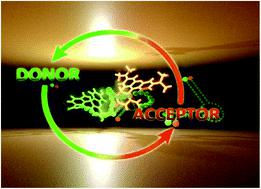当前位置:
X-MOL 学术
›
Chem. Sci.
›
论文详情
Our official English website, www.x-mol.net, welcomes your
feedback! (Note: you will need to create a separate account there.)
Polariton-assisted manipulation of energy relaxation pathways: donor–acceptor role reversal in a tuneable microcavity
Chemical Science ( IF 7.6 ) Pub Date : 2021-08-31 , DOI: 10.1039/d1sc02026a Dmitriy Dovzhenko 1, 2 , Maksim Lednev 1 , Konstantin Mochalov 1, 3 , Ivan Vaskan 1, 3, 4 , Yury Rakovich 5, 6 , Alexander Karaulov 7 , Igor Nabiev 1, 7, 8
Chemical Science ( IF 7.6 ) Pub Date : 2021-08-31 , DOI: 10.1039/d1sc02026a Dmitriy Dovzhenko 1, 2 , Maksim Lednev 1 , Konstantin Mochalov 1, 3 , Ivan Vaskan 1, 3, 4 , Yury Rakovich 5, 6 , Alexander Karaulov 7 , Igor Nabiev 1, 7, 8
Affiliation

|
Resonant interaction between excitonic transitions of molecules and localized electromagnetic field allows the formation of hybrid light–matter polaritonic states. This hybridization of the light and the matter states has been shown to significantly alter the intrinsic properties of molecular ensembles placed inside the optical cavity. Here, we have observed strong coupling of excitonic transition in a pair of closely located organic dye molecules demonstrating an efficient donor-to-acceptor resonance energy transfer with the mode of a tuneable open-access cavity. Analysing the dependence of the relaxation pathways between energy states in this system on the cavity detuning, we have demonstrated that predominant strong coupling of the cavity photon to the exciton transition in the donor dye molecule can lead not only to an increase in the donor–acceptor energy transfer, but also to an energy shift large enough to cause inversion between the energy states of the acceptor and the mainly donor lower polariton energy state. Furthermore, we have shown that the polariton-assisted donor–acceptor chromophores' role reversal or “carnival effect” not only changes the relative energy levels of the donor–acceptor pair, but also makes it possible to manipulate the energy flow in the systems with resonant dipole–dipole interaction and direct energy transfer from the acceptor to the mainly donor lower polariton state. Our experimental data are the first confirmation of the theoretically predicted possibility of polariton-assisted energy transfer reversal in FRET systems, thus paving the way to new avenues in FRET-imaging, remote-controlled chemistry, and all-optical switching.
中文翻译:

极化子辅助能量弛豫途径的操纵:可调微腔中的供体-受体作用逆转
分子激子跃迁与局部电磁场之间的共振相互作用允许形成混合光-物质极化状态。光和物质状态的这种混合已被证明会显着改变放置在光学腔内的分子集合的内在特性。在这里,我们观察到一对紧密定位的有机染料分子中激子跃迁的强耦合,证明了有效的供体-受体共振能量转移,具有可调开放式腔的模式。分析该系统中能量状态之间的弛豫路径对腔失谐的依赖性,我们已经证明,腔光子与供体染料分子中的激子跃迁的主要强耦合不仅可以导致供体 - 受体能量转移的增加,而且还可以导致足够大的能量偏移以导致能量状态之间的反转受体和主要供体的低极化子能态。此外,我们已经证明,极化子辅助的供体 - 受体发色团的角色逆转或“狂欢效应”不仅改变了供体 - 受体对的相对能级,而且使得操纵系统中的能量流成为可能共振偶极子 - 偶极子相互作用和从受体到主要供体低极化状态的直接能量转移。
更新日期:2021-09-07
中文翻译:

极化子辅助能量弛豫途径的操纵:可调微腔中的供体-受体作用逆转
分子激子跃迁与局部电磁场之间的共振相互作用允许形成混合光-物质极化状态。光和物质状态的这种混合已被证明会显着改变放置在光学腔内的分子集合的内在特性。在这里,我们观察到一对紧密定位的有机染料分子中激子跃迁的强耦合,证明了有效的供体-受体共振能量转移,具有可调开放式腔的模式。分析该系统中能量状态之间的弛豫路径对腔失谐的依赖性,我们已经证明,腔光子与供体染料分子中的激子跃迁的主要强耦合不仅可以导致供体 - 受体能量转移的增加,而且还可以导致足够大的能量偏移以导致能量状态之间的反转受体和主要供体的低极化子能态。此外,我们已经证明,极化子辅助的供体 - 受体发色团的角色逆转或“狂欢效应”不仅改变了供体 - 受体对的相对能级,而且使得操纵系统中的能量流成为可能共振偶极子 - 偶极子相互作用和从受体到主要供体低极化状态的直接能量转移。











































 京公网安备 11010802027423号
京公网安备 11010802027423号